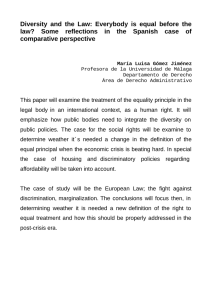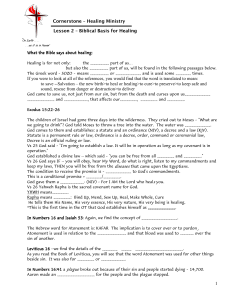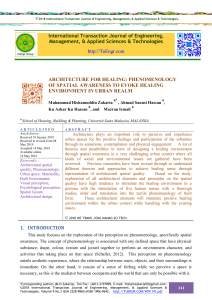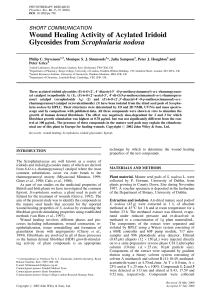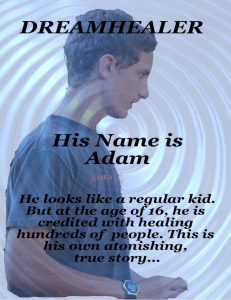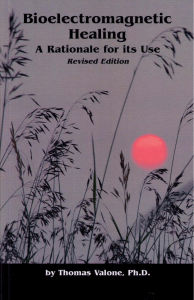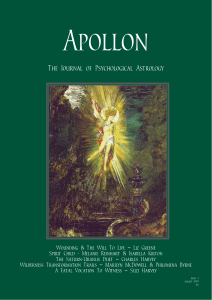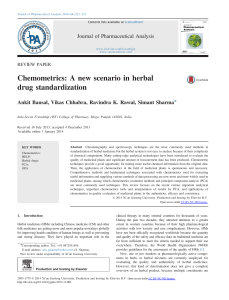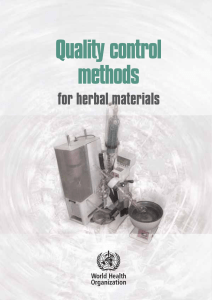Artículo - Universitat de Barcelona
Anuncio
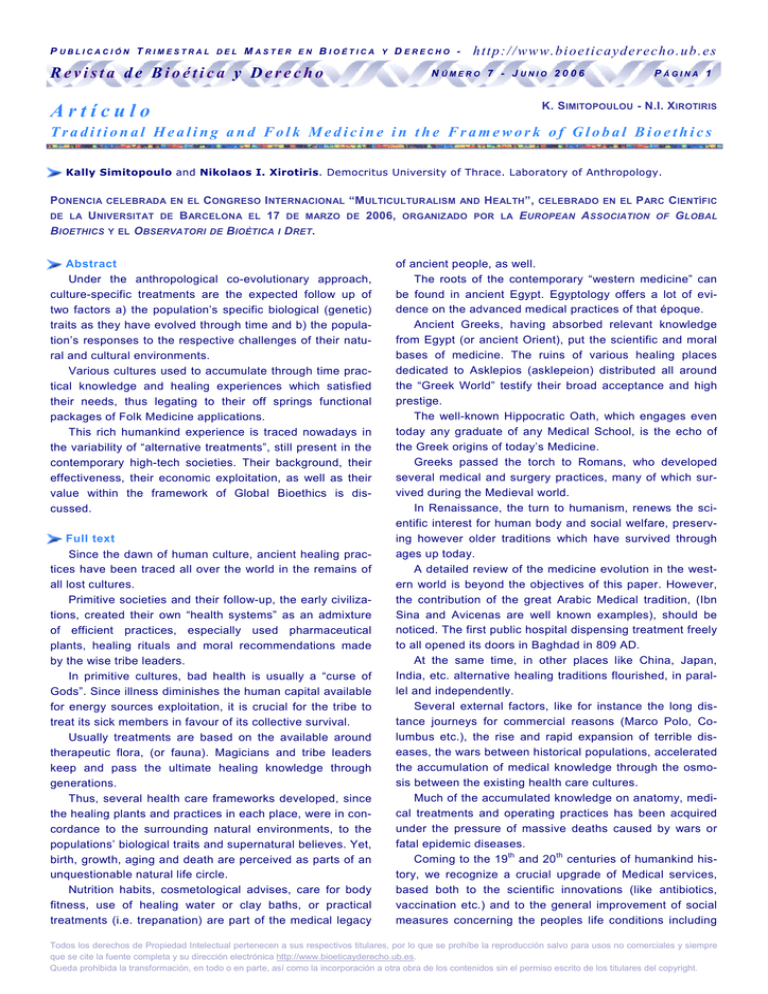
P UBLICACIÓN TRIMESTRAL DEL MASTER EN BIOÉTICA Y DERECHO - Revista de Bioética y Derecho Artículo h t t p : / / w w w . b i o eti ca yd e r e ch o . u b . e s NÚMERO 7 - JUNIO 2 0 06 P ÁGINA 1 K. SIMITOPOULOU - N.I. XIROTIRIS Traditional Healing and Folk Medicine in the Framework of Global Bioethics Kally Simitopoulo and Nikolaos I. Xirotiris. Democritus University of Thrace. Laboratory of Anthropology. PONENCIA CELEBRADA EN EL CONGRESO INTERNACIONAL “MULTICULTURALISM AND HEALTH”, CELEBRADO EN EL P ARC CIENTÍFIC DE LA U NIVERSITAT DE B ARCELONA EL 17 DE MARZO DE 2006, ORGANIZADO POR LA E UROPEAN A SSOCIATION OF G LOBAL BIOETHICS Y EL OBSERVATORI DE BIOÈTICA I DRET. Abstract Under the anthropological co-evolutionary approach, culture-specific treatments are the expected follow up of two factors a) the population’s specific biological (genetic) traits as they have evolved through time and b) the population’s responses to the respective challenges of their natural and cultural environments. Various cultures used to accumulate through time practical knowledge and healing experiences which satisfied their needs, thus legating to their off springs functional packages of Folk Medicine applications. This rich humankind experience is traced nowadays in the variability of “alternative treatments”, still present in the contemporary high-tech societies. Their background, their effectiveness, their economic exploitation, as well as their value within the framework of Global Bioethics is discussed. Full text Since the dawn of human culture, ancient healing practices have been traced all over the world in the remains of all lost cultures. Primitive societies and their follow-up, the early civilizations, created their own “health systems” as an admixture of efficient practices, especially used pharmaceutical plants, healing rituals and moral recommendations made by the wise tribe leaders. In primitive cultures, bad health is usually a “curse of Gods”. Since illness diminishes the human capital available for energy sources exploitation, it is crucial for the tribe to treat its sick members in favour of its collective survival. Usually treatments are based on the available around therapeutic flora, (or fauna). Magicians and tribe leaders keep and pass the ultimate healing knowledge through generations. Thus, several health care frameworks developed, since the healing plants and practices in each place, were in concordance to the surrounding natural environments, to the populations’ biological traits and supernatural believes. Yet, birth, growth, aging and death are perceived as parts of an unquestionable natural life circle. Nutrition habits, cosmetological advises, care for body fitness, use of healing water or clay baths, or practical treatments (i.e. trepanation) are part of the medical legacy of ancient people, as well. The roots of the contemporary “western medicine” can be found in ancient Egypt. Egyptology offers a lot of evidence on the advanced medical practices of that époque. Ancient Greeks, having absorbed relevant knowledge from Egypt (or ancient Orient), put the scientific and moral bases of medicine. The ruins of various healing places dedicated to Asklepios (asklepeion) distributed all around the “Greek World” testify their broad acceptance and high prestige. The well-known Hippocratic Oath, which engages even today any graduate of any Medical School, is the echo of the Greek origins of today’s Medicine. Greeks passed the torch to Romans, who developed several medical and surgery practices, many of which survived during the Medieval world. In Renaissance, the turn to humanism, renews the scientific interest for human body and social welfare, preserving however older traditions which have survived through ages up today. A detailed review of the medicine evolution in the western world is beyond the objectives of this paper. However, the contribution of the great Arabic Medical tradition, (Ibn Sina and Avicenas are well known examples), should be noticed. The first public hospital dispensing treatment freely to all opened its doors in Baghdad in 809 AD. At the same time, in other places like China, Japan, India, etc. alternative healing traditions flourished, in parallel and independently. Several external factors, like for instance the long distance journeys for commercial reasons (Marco Polo, Columbus etc.), the rise and rapid expansion of terrible diseases, the wars between historical populations, accelerated the accumulation of medical knowledge through the osmosis between the existing health care cultures. Much of the accumulated knowledge on anatomy, medical treatments and operating practices has been acquired under the pressure of massive deaths caused by wars or fatal epidemic diseases. Coming to the 19th and 20th centuries of humankind history, we recognize a crucial upgrade of Medical services, based both to the scientific innovations (like antibiotics, vaccination etc.) and to the general improvement of social measures concerning the peoples life conditions including Todos los derechos de Propiedad Intelectual pertenecen a sus respectivos titulares, por lo que se prohíbe la reproducción salvo para usos no comerciales y siempre que se cite la fuente completa y su dirección electrónica http://www.bioeticayderecho.ub.es. Queda prohibida la transformación, en todo o en parte, así como la incorporación a otra obra de los contenidos sin el permiso escrito de los titulares del copyright. P UBLICACIÓN TRIMESTRAL DEL MASTER EN BIOÉTICA Y DERECHO - Revista de Bioética y Derecho h t t p : / / w w w . b i o eti ca yd e r e ch o . u b . e s NÚMERO 7 - JUNIO 2 0 06 P ÁGINA 2 Artículo health-care. However, the battle for a better health care available to all contemporary people, is a dynamic procedure, since a) new threats keep arising during the effort to combat the previous ones (i.e new viruses, or “civilization diseases” like cancer, arteriosclerosis, obesity and diabetes). In spite of our advanced weapons against health treats, we are in the middle of a continuous war for the acquisition of global health standards, a goal that is still far enough from our wishes. In this war no effective healing practice should be excluded. The recent biotechnological revolution, has introduced a lot of new elements in the concept, the techniques and the perspectives of medical care. In the DNA era, stem cells, individualised pharmaceutical or genetic therapies, xenotransplantations, artificial reproduction methods and so on, constitute the main framework, within which we “westerns” face the health and welfare issues. Actually, within the context of Reductionism and Rationalism, our culture faces the human body as an explicable machine of sophisticated mechanisms. It is in general accepted that knowing the parts, leads to the answers concerning the total. Thus, Western Medicine hardly considers: - the delicate and complex nature of human organism - the continuous interaction and synergy among its parts - the impact of the co-evolving living environment (from micro-organisms to ecosystems) - the sensitive balance of all health components (living conditions, clean water supply, stress etc.) - the deviation of modern humans from their natural background (artificial and polluted living environments in big cities, GMOs used in food chain, etc.) - the life-style and self-consciousness as a health factors - the mental contribution of the patient in his own healing - the long lasting healing traditions and effective practices, which survived for centuries before the appearance of the contemporary Medicine. - - In reality, we overestimate and over-trust: the rapidly accumulated knowledge of human genetics the, indeed astonishing, new technologies in pharmaceutical or surgery practices the exclusive authorization of experts for therapy provision. (The patient is dealt as a pathetic object for treatment and not an autonomous subject) the unquestionable power of the contemporary (western) science the dependence of health status upon money availability In our societies we enjoy nowadays a much higher health status that that of the past. However, considering the situation worldwide, the gap between advanced countries and third world is very disappointing. It is obvious that the sophisticated new therapies are addressed exclusively to reach people, who have extreme luxurities, like the possibility to preserve their dead bodies in deep freezing, whereas millions of people suffer from malaria, AIDS or even lack of potable water. Several physicians of the third world claim that even the terms “traditional healing” or “alternative treatments” reflect the spirit of western superiority and dominance over other cultures with great ancient tradition, which has been vanished in the competitive rash of Anglo-Saxon Medicine. They refer to another version of the war between cultures. Anyway, the wealth of other cultures’ knowledge on health issues obviously deserves more attention, since, precious healing legacy (e.g. that of China or far East) has been ignored. Holistic approaches and human principles basic for the good health status according to these traditions are hardly appreciated by our scientific approaches. Despite this, alternative therapies and traditional healing methods, are present both in the developed and the third world, either officially accepted or not. Many people still trust the therapeutic efficiency of such methods sometimes to an extreme degree, since they believe to the healing power of meta-physic rituals, of Magic and supernatural forces, of religious ceremonies and so on… It seems that the public opinion accepts that Traditional Medicine (TM) and Complementary Alternative Therapies (CAM): - have positive results in many cases - respond to the cultural tradition of particular population groups - are more compatible to the patients’ believes and life styles - are more familiar, easily applicable, less laborious and painful - have less collateral effects for the patient - are cost effective - are not always far from the modern scientific findings. (modern science rediscovers the value of healing plants ingredients and tries to exploit traditional knowledge for pharmaceutical industry). According to the World Health Organization: - In Europe & North America, over 50% of the population have used CAM at least once. Todos los derechos de Propiedad Intelectual pertenecen a sus respectivos titulares, por lo que se prohíbe la reproducción salvo para usos no comerciales y siempre que se cite la fuente completa y su dirección electrónica http://www.bioeticayderecho.ub.es. Queda prohibida la transformación, en todo o en parte, así como la incorporación a otra obra de los contenidos sin el permiso escrito de los titulares del copyright. P UBLICACIÓN TRIMESTRAL DEL MASTER EN BIOÉTICA Y DERECHO - Revista de Bioética y Derecho h t t p : / / w w w . b i o eti ca yd e r e ch o . u b . e s NÚMERO 7 - JUNIO 2 0 06 P ÁGINA 3 Artículo - - In San Francisco, London and South Africa, 75% of people with HIV/AIDS use TM/CAM. In Canada, 70% of the population have used complementary medicine at least once. In Germany 90% of the population have used a natural remedy at some point in their life. In USA, 158 million of the adult population use complementary medicines, 17 billion US $ was spent on traditional remedies in 2000. (USA Commission for Alternative and Complementary medicines). In China, traditional herbal preparations account for 30%-50% of the total medicinal consumption. In Ghana, Mali, Nigeria and Zambia, the first line of treatment for 60% of children with high fever resulting from malaria is the use of herbal medicines at home. The global market for herbal medicines currently stands at over US $ 60 billion annually and is growing steadily. 70 countries have a national regulation on herbal medicines but the legislative control of medicinal plants has not evolved around a structured model. This is because medicinal products or herbs are defined differently in different countries and diverse approaches have been adopted with regard to licensing, dispensing, manufacturing and trading. Consequently, WHO recognizes that TM/CAM nowadays reveal a noticeable potential, since: a) The health status in a great part of the third world is related to the broad applications of such alternative medical practices. b) The recent increasing migration movements towards western countries, creates within them a fruitful osmosis between co-existing cultures. c) Traditional knowledge could be a precious source of information for our therapeutic framework. d) The use of TM/CAM in parallel to contemporary science-based Medicine, constitutes an additional weapon of the humankind against the today’s health threats. According to WHO, Traditional Medicine or Complementary Alternative Medicine refers to health practices, approaches, knowledge and beliefs incorporating plant, animal & mineral based medicines, spiritual therapies, manual techniques & exercises, applied singularly or in combination to treat, diagnose and prevent illnesses or maintain well-being. Within this definition, several healing methods are included like for instance acupuncture, Yoga, use of pharmaceutical plants, chiropractics etc. However WHO notices that: Scientific evidence from clinical trials is only strong for many uses of acupuncture, some herbal medicines and for some of the manual therapies. Further research is needed to ascertain the efficacy and safety of several other practices and medicinal plants, since unregulated or inappropriate use of traditional medicines and practices can have negative or dangerous effects. WHO also pays attention on: a) Biodiversity and sustainability issues There is the risk that a growing herbal market and its great commercial benefit might pose a threat to biodiversity through the over harvesting of the raw material for herbal medicines and other natural health care products. These practices, if not controlled, may lead to the extinction of endangered species and the destruction of natural habitats and resources. b) Legislation issues At present, the requirements for protection provided under international standards for patent law and by most national conventional patent laws are inadequate to protect traditional knowledge and biodiversity. WHO increases its efforts in promoting safe, effective and affordable traditional medicine, thus it launched its first ever comprehensive traditional medicine strategy in 2002. The strategy is designed to assist countries to: - Develop national policies on the evaluation and regulation of TM/CAM practices - Promote TM/CAM integration into national health care systems in line with the provisions of the WHO strategies - Create a stronger evidence base on the safety, efficacy and quality of the TAM/CAM products and practices - Implement regulatory mechanisms to control them - Document traditional medicines and remedies - Ensure availability and affordability of TM/CAM including essential herbal medicines - Arise public awareness about safe and effective TM/ CAM therapies - Cultivate and conserve medicinal plants to ensure their sustainable use During the Global Conference on the Role of Traditional Medicine In Reproductive Health, held in Minneapolis USA in 28 July 2005, the following declaration was adopted: Traditional Healing Practices and Researches must be guaranteed to all peoples by states’ governments and indigenous governments alike. Traditional Healing Practice and Conventional Medicine Todos los derechos de Propiedad Intelectual pertenecen a sus respectivos titulares, por lo que se prohíbe la reproducción salvo para usos no comerciales y siempre que se cite la fuente completa y su dirección electrónica http://www.bioeticayderecho.ub.es. Queda prohibida la transformación, en todo o en parte, así como la incorporación a otra obra de los contenidos sin el permiso escrito de los titulares del copyright. P UBLICACIÓN TRIMESTRAL DEL MASTER EN BIOÉTICA Y DERECHO - Revista de Bioética y Derecho h t t p : / / w w w . b i o eti ca yd e r e ch o . u b . e s NÚMERO 7 - JUNIO 2 0 06 P ÁGINA 4 Artículo Practice must be recognized in parallel and not integrated one into the other. Each indigenous nation must reclaim control over their knowledge through indigenous science and research, to extend traditional knowledge for the benefit of each nation. The outcome of this conference must be submitted for further action at the Ghana Global Summit on HIV/ AIDS, Traditional Medicine & Indigenous Knowledge, slated for March 14-18, 2006. The achievement of the Ghana Global Summit must be solidified by the objectives of the Indigenous Healing Conference On Chronic Diseases (Cancer, Diabetes, Mental and Heart Illnesses) planned for Minneapolis, Minnesota for July 12-15, 2006. Support the terms and conditions contained in all previous and subsequent Declarations on the Rights of Indigenous Peoples, including the Indigenous Peoples of the World Working Group Draft Declaration. In the European Union, an open panel concerning the promotion of TM/CAM is the European Forum for Complementary and Alternative Medicine (c/o European Public Health Alliance, Rue d’Arlon 39-41, B-1000 Brussels, Belgium). Being aware that people in Europe are seeking a more holistic approach to healthcare, the European Forum declares that: - CAM to health care are used across the EU by a high and increasing percentage of the public. - CAM is practised by medical doctors and healthcare professionals across the EU each within the boundaries of their own competence. - CAM is not uniformly recognised throughout the EU. - Access to CAM care varies from country to country and between socio-economic groups. - Costs of conventional care continue to rise while the preventive and curative approaches of CAM. - CAM offer both short-term and long-term cost benefits. In 1997 the European Parliament called on the EU Commission to act in the area of CAM (European Parliament, Resolution on the status of non-conventional medicine A-0075/1997). The principles on which CAM should be based according to the European spirit, are: - Holistic approach - Stimulation of self-healing capacity - Use of natural sources - Safety of patients and users - Traditional and established use Openness to innovation Prevention instead healing Health and curative support Possibility for use in combinations or individually Increasing the range of options for patient care and treatment Promoting self-responsibility for health Referring to the role of the European association of Global Bioethics to this debate, we could indeed contribute to clarify the picture concerning TM / CAM in Europe, since it is rather unclear for the EU citizen. The multicultural composition of our societies, in combination to the fuzzy relevant information, introduces new dilemmas both for physicians and patients originating from their diverse backgrounds. Referring to alternative therapies at individual level, on one side, there is an increasing demand for them, partly justified by the extremities and the high cost of conventional Medicine, whereas on the other, the possibility of involvement in naive, ineffective, time consuming and finally dangerous treatments is considerable indeed. The, always present economic factors, hidden behind our wish for well being, could make the patients exploitable by immoral trickster “healers”, especially because the reliability of such methods still suffers from lack of scientific documentation. We should attract the public attention on: - The exploitation of the special flora and fauna by pharmaceutical by pharmaceutical companies, which actually threatens the precious biodiversity. - The “bio-piracy” and patenting of traditional knowledge, in absentia of its natural owners. - The low level of public understanding in life sciences, medical applications and new technologies. - The particular religious beliefs of several people, which sometimes mislead them in health care issues. - The increasing prestige of pseudo-science, astrology, and mysticism in broad social layers, due to their poor education. - The self-evident of human rights of any individual referring also to health care and personal dignity in disease. Within this framework, where no easy answers are available, EAGB could enrich the debate on Traditional Medicine, following its own statutes and W.H.O. guide lines, so as to increase public awareness and promote conscious decision making… Todos los derechos de Propiedad Intelectual pertenecen a sus respectivos titulares, por lo que se prohíbe la reproducción salvo para usos no comerciales y siempre que se cite la fuente completa y su dirección electrónica http://www.bioeticayderecho.ub.es. Queda prohibida la transformación, en todo o en parte, así como la incorporación a otra obra de los contenidos sin el permiso escrito de los titulares del copyright.
